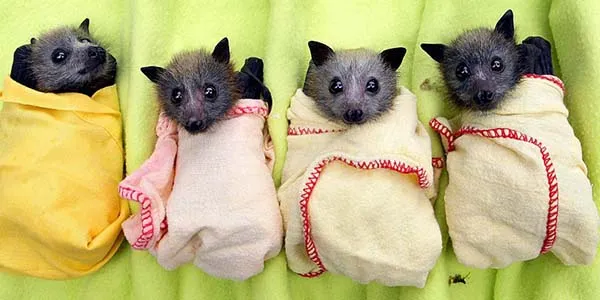Just like all mammals, bats have a gestation period, which is the time between conception and birth. Most bat species give live birth to only one pup per year. However, some species can give birth to twins.
When the baby bat is born it weighs about one-third of its mother’s weight and the newborn pup hangs on tightly with their hind claws while hanging upside down by their mouths which are suckling from her nipple. Most mothers do not leave the roost until they have taught the pup how to fly properly at around five weeks old because they are still too small for them to be left unattended in the wild during this time period. In this article, we will answer some of the most common questions about bat babies!
How many babies do bats have
Most bats give birth to one baby pup a year. Other species, like the hoary bat, can have as many as four. For 3 to 4 weeks, the baby is incapable of flying and is latched onto its mother’s nipple. It is not until they are about five weeks old that the baby bat can begin flying lessons and leaves its roost.
When do bats have babies
Bats have what we call a Maternity season, which is the time of year when female bats give birth to bat babies. This maternal season usually takes place around May 15 to August 15 but may vary depending on the species, climate, and where the bats live. During this season, female bats give birth to baby bats and the whole colony is occupied with taking care of the young, usually taking turns raising and feeding them.
Bat Calendar
Bats’ reproduction cycle is quite predictable, they don’t really deviate from this yearly pattern. Here’s a bat calendar to help you understand when the females are pregnant, giving birth, and caring for the young bats.
January and February – This time of the year, the bats are in hibernation. They are in their caves or mines and will not be seen until the spring comes around again when it is time for them to mate.
March – Depending on where they are and whether it’s still cold, they could wake up and come out of their hiding places or they may choose to stay and wait until warmer weather.
April – They will start emerging from their caves in search of food (insects). This is also when the breeding season begins.
May – The bats start forming colonies. Females create maternity colonies and male bats create bachelor colonies. You will start seeing pregnant female bats flying around your neighborhood at night in search of potential nesting sites such as attics or barns.
June – Females will start eating huge amounts of insects to prepare for the birthing season.
July – By this time, most of the female bats have given birth and now their main priority is taking care of the newborns by feeding them until they are able to fly on their own.
August – This is when baby bats start to learn how to fly and forage for food.
September-October – Bats are now busy looking for roosting sites and eating huge amounts of insects to prepare for winter hibernation.
November–December – Hibernation begins.
Bat maternity season and bat removal
During bats’ maternity season, it is illegal to conduct bat abatement from your home. Bats are protected during this time of year. There are flightless pups in the colony and if you remove the mothers, the baby bats will die since they are completely dependent on their mothers. The maternal season may be the most important time of year for these tiny mammals. If you do bat exclusion or harm/kill one during this critical period – it could land you stiff fines or even jail time. Most times, it is best to just let the maternal season pass and wait for the bats to move into their winter hibernaculum. Once the season passed you can start thinking about evicting them. If you need advice regarding bat infestation during this season, contact AAAC Wildlife Removal!
Colonies and Maternity Roost
In the maternal season, The females gather and create maternity roosts to give birth and raise their pups. The whole roost is occupied with looking after the baby bats and taking turns caring for them while other members of the colony hunt. After five weeks, when baby bats are big enough and can learn how to survive on their own, they leave along with adult colonies who will find a new place to live together.
How are baby bats born
Bats are mammals, so a female bat gives birth to a live baby and do not lay eggs. Astonishingly, females give birth while hanging upside down! The mother pushes her pup out of her womb towards her feet and then catch it to prevent it from falling to the ground. Once they’re out of the womb, their mothers will groom their pups and then move them onto her chest where they can suckle.

What are baby bats like ?
Newborn bat pups weigh only two or three grams! They have no fur but instead have fine, downy hair. At this stage of development, the wings do not function well enough for flying so you will see the little ones hanging on to mom while its parent is feeding or roosting during the day with other baby bats clumped together.
How big are baby bats?
The newborn is only around 1 or 2 inches long when they come out of the womb. However, relative to the weight of the mother bat, they are quite heavy and can weigh as much as a third of the mother’s weight.
What do bats feed bat babies?
Just like all baby mammals, baby bats suckle milk from mother bats until they are weaned. Mother bats produce it to feed their young for about three weeks and the babies will drink them until they can fly on their own. Some species feed their young with regurgitated nectar where the pups lick at their mother’s mouth and the mother vomits a meal for the young to eat. Learn more about the strange things bats can do.
How do bats carry their babies?
Bat mothers are very protective of their young and they will go through a lot for them. The mother keeps her baby attached to a nipple inside her wings throughout its development until it becomes self-sufficient enough to live on its own, which could take up to six weeks or more depending on how old the pup is when it leaves mommy’s side. Large kinds such as the Big Brown bat hold and cradle babies within the fold of skin under its wing, while some species have special pockets near mammary glands to keep their pups safe.
How long do bats stay with their mothers?
In general, mothers stay with their young for about two months. This is to ensure that her baby’s immune system and other bodily functions are strong enough to survive on their own outside of the roost. During this time, the baby bats can drink milk and learn how to fly; they even attempt flying on their own while also trying out exploring/foraging food sources. Once a mother feels that her pup is ready-and-able to take care of itself independently (i.e., it’s self-sufficient), she will then leave her maternity roost in search of food exclusively for herself.

Baby bat nest in the attic
Many bat species make their habitat in homes. It is common for them to roost in crawlspaces or attics. When they are raising their young it can be difficult to remove them without causing harm. If you find that there’s been an infestation by bats in your home. Be sure to contact wildlife professionals. DIY removal is never a good idea as it may cause harm to the baby bats, not to mention you exposing yourself to the risk of disease from bat poop in the attic. If you come across a nest on your attic or rooftop call wildlife control services immediately before any more damage occurs.
Bat Removal Services
For professional and humane bat removal contact AAAC Wildlife Removal. We provide humane wildlife control for bats or other wild animals including raccoons, skunks, and snakes that can cause damage to your home or property. Our team is experienced and knowledgeable about local laws regarding animal trapping and exclusion so you can have peace of mind knowing these creatures won’t be back! If you have any questions about pups or bat removal in general, please feel free to contact us and we will be happy to assist you with your questions. We are available 24/7 for all of your bat control needs!
FAQs
Are bats mammals?
Yes! Bats are the only that have evolved to fly. They belong to the order Chiroptera, one of several orders in class Mammalia (all mammals).
Do bats create nests?
Bats do not build nests, they create roosting sites. A roosting site is a place where a bat will sleep, rest or hibernate. Bat mothers and their young create maternity colonies in which they share these sites together during times of the year when mating takes place (May 15 to August 15).
What is a bat’s diet?
Bats eat fruit, nectar, and sometimes insects or other small animals that happen to cross their path while foraging at night. The lesser long-nosed bats feed on flower nectars or fruits.
Originally published on https://aaacwildliferemoval.com/blog/bats/how-many-babies-do-bats-have




